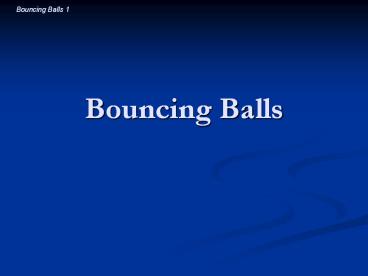Bouncing Balls - PowerPoint PPT Presentation
Title:
Bouncing Balls
Description:
Title: How Things Work Author: Louis Bloomfield Last modified by: AK Created Date: 8/31/1999 7:25:18 PM Document presentation format: On-screen Show – PowerPoint PPT presentation
Number of Views:375
Avg rating:3.0/5.0
Title: Bouncing Balls
1
Bouncing Balls
2
Introductory Question
- If you place a tennis ball on a basketball and
drop this stack on the ground, how high will the
tennis ball bounce? - To approximately its original height
- Much higher than its original height
- Much less than its original height
3
Observations aboutBouncing Balls
- Some balls bounce better than others
- Dropped balls dont rebound to their full height
- Balls bounce differently from different surfaces
- Ball bounce differently from moving objects
4
4 Questions about Bouncing Balls
- Why cant a ball thats dropped on a hard floor
rebound to its starting height? - Why does the floors surface affect the bounce?
- How does a ball bounce when it hits a bat?
- What happens to the bat when a ball hits it?
5
Question 1
- Why cant a ball thats dropped on a hard floor
rebound to its starting height? - What happens to balls energy as it bounces?
6
Bouncing from a Rigid Floor
- As it strikes a rigid floor, a balls
- kinetic energy decreases by the collision
energy - elastic potential energy increases as it dents
- As it rebounds from that surface, the balls
- elastic potential energy decreases as it undents
- kinetic energy increases by the rebound energy
- Rebound energy lt collision energy
- A lively ball wastes little energy as thermal
energy - A dead ball wastes most of its energy
7
(No Transcript)
8
Measuring a Balls Liveliness
- Coefficient of Restitution
- is a measure of a balls liveliness
- is the ratio of outgoing to incoming speeds
- coefficient of restitution outgoing speed /
incoming speed
9
Question 2
- Why does the floors surface affect the bounce?
10
Bouncing from an Elastic Floor
- Both ball and floor dent during a bounce
- Work is proportional to dent distance
- Denting floor stores and returns energy
- A lively floor wastes little energy
- A dead floor wastes most of its energy
- A floor has a coefficient of restitution, too
- A soft, lively floor can help the ball bounce!
11
Question 3
- How does a ball bounce when it hits a bat?
- Do both the ball and bat bounce?
12
Bouncing from Moving Surfaces
- Incoming speed ? approaching speed
- Outgoing speed ? separating speed
- Coefficient of Restitution becomes
- coefficient of restitution separating speed
/ approaching speed
13
Ball and Bat (Part 1)
- Ball heads toward home plate at 100 km/h
- Bat heads toward pitcher at 100 km/h
- Approaching speed is 200 km/h
14
Ball and Bat (Part 2)
- Approaching speed is 200 km/h
- Baseballs coefficient of restitution 0.55
- Separating speed is 110 km/h
15
Ball and Bat (Part 3)
- Separating speed is 110 km/h
- Bat heads toward pitcher at 100 km/h
- Ball heads toward pitcher at 210 km/h
16
Introductory Question (revisited)
- If you place a tennis ball on a basketball and
drop this stack on the ground, how high will the
tennis ball bounce? - To approximately its original height
- Much higher than its original height
- Much less than its original height
17
Question 4
- What happens to the bat when a ball hits it?
18
Bouncings Effects on Objects
- A bouncing ball transfers momentum
- while stopping
- while rebounding
- A livelier ball transfers more momentum
- A bouncing ball can also transfer energy
- These two transfers together govern bouncing
- A ball transfers momentum and energy to a bat
- Identical elastic balls can transfer motion
perfectly
19
Impact Forces
- Harder surfaces bounce faster
- Momentum is transferred more quickly
- Time is shorter, so force is larger
- No one likes bouncing off hard surfaces
20
The Balls Effects on a Bat
- The ball pushes the bat back and twists it, too
- When the ball hits the bats center of
percussion, - the bats backward and rotational motions balance
- the bats handle doesnt jerk
- When the ball hits the bats vibrational node,
- the bat doesnt vibrate
- more energy goes into the ball
21
(No Transcript)
22
(No Transcript)
23
Summary about Bouncing Balls
- Each ball has a coefficient of restitution
- Energy lost in a bounce becomes thermal
- The surface can affect a balls bounce
- Surfaces bounce, too

